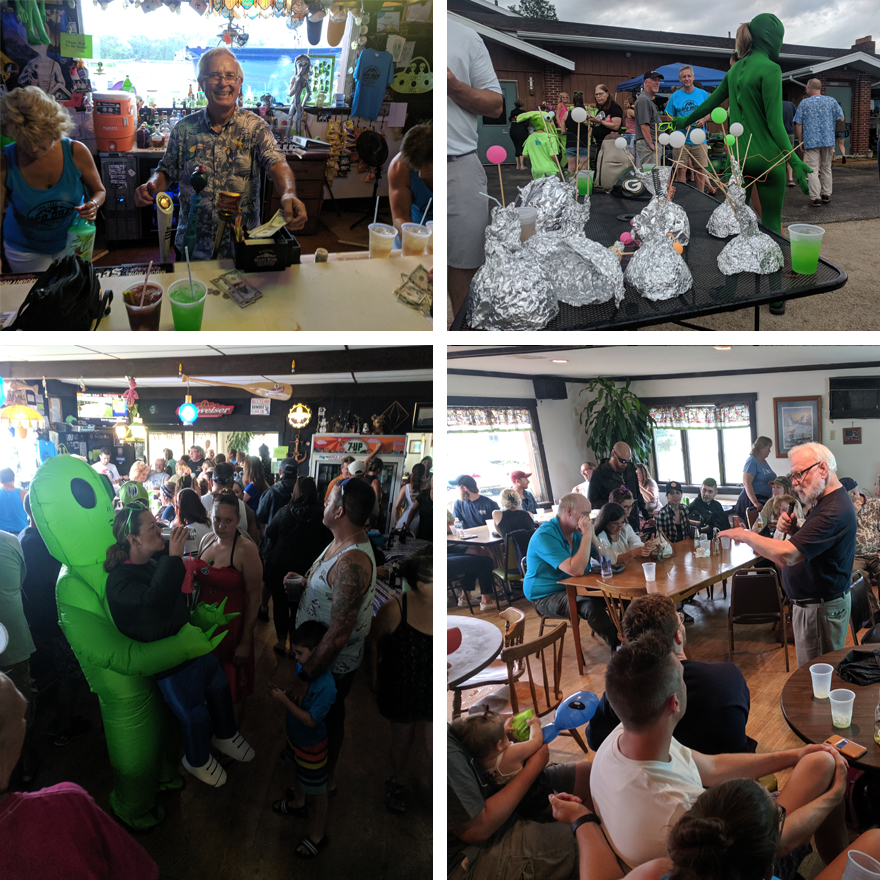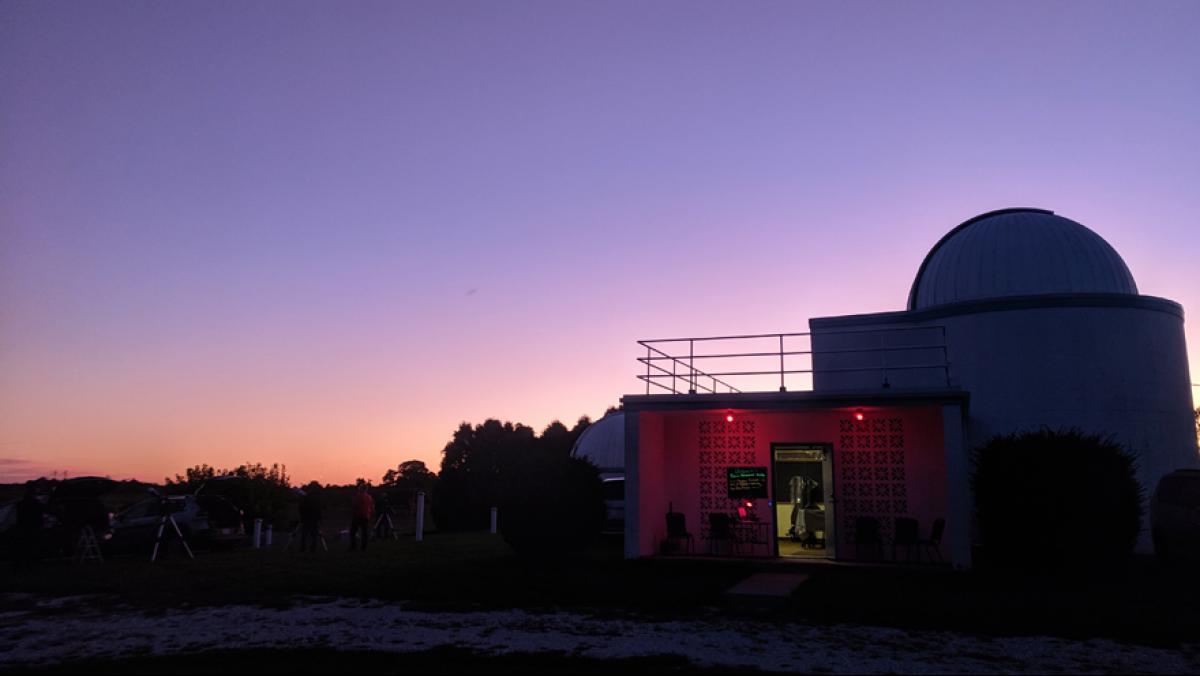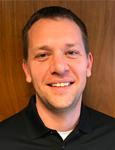Eight times a year the Racine Astronomical Society invites the public to view the skies through two intricate telescopes housed at the Modine-Benstead Observatory. Tucked amid rolling cornfields and tidy McMansions in rural Yorkville, the twin silos of the whitewashed observatory look like the tops of grain silos. Each holds a powerful telescope. Established nearly sixty years ago through the largesse of local manufacturers and publishers, the observatory today reveals to hundreds of annual visitors the secrets of the heavens.
On a warm August night when the observatory is open to the public, one of the visitors is an exuberant man in his 60s with a head bandage. He walks through the small doorway, awash in red light, ahead of a middle-aged man and his overall-clad father who mentions how he first came here as a Boy Scout. These are people who grew up with mnemonics of the planets, lived through Pluto’s demotion, saw televised disasters in space. Yet for most it is their first visit to an observatory. Perhaps they think they already know what the planets and stars will look like close up. After all, the sky is there all day and all night.

“Many of the visitors that come out on a public night have never looked through a telescope,” says Brian Jensen, president of the Racine Astronomical Society. The fifty-member, volunteer-run society has brought together hobbyists since 1956 to explore and document the nighttime skies. “We enjoy sharing our passion with others,” says Jensen. “It is always fun seeing the excitement of a visitor looking at Saturn for the first time.”
Through the eyepiece of the custom-built, sixteen-inch Newtonian-Cassegrain reflecting telescope, Saturn appears neon white, so close that one can make out its shadow on the bold, blade-like ring. It’s right there, huge and not at all cartoonish. It is right there, the most outrageous body in immediate space, making small the ticking of today’s clock, grounding concerns over work or friends or sports. At the same time, it’s not close: the wind creates an oily sheen in the frame, says a volunteer from the society, as if to remind us this planet is a humbling 746 million miles away.
Consider for a moment that distance.
• • • • •
Taking time for deep reflection on deepest space, time away from demanding phones and clocks and cars and our own chattering minds, seems a luxury. Yet it is important, a reminder that everyone is searching, wild and stupid with no sure path, under the same massive unknown.
This search can come in many forms. While some gather in the fields outside of Racine to peer at the planets through powerful telescopes, others gather in Manitowoc to celebrate a piece of 1960s-era space junk. Visitors to the Rahr-West Art Museum gaze in wonder at a replica of the original piece of Sputnik IV that crash landed in downtown Manitowoc on September 5, 1962. Placed under a Plexiglas case and wedged between an exhibit of Star Trek memorabilia and a series of tastefully framed oil paintings, this charred hunk of metal is one of the museum’s most popular exhibits.
After the pioneering Soviet satellite broke up in the atmosphere, a piece of it fell to Earth and embedded itself into 8th Street. The piece, still warm from the friction of re-entry into the atmosphere, was discovered by two beat cops who promptly sent the object to the Smithsonian Museum (which later, somewhat mockingly, returned it to the Soviet Union).
Although the Soviets never officially confirmed that a part of Sputnik actually made the still-preserved hole in 8th street (there’s a brass ring around it today), Manitowoc laid claim to the famous satellite nonetheless. Every year, residents gather together with alien lovers from galaxies near and far to celebrate Sputnikfest, which puts a cosmic twist on the Wisconsin block party. The event also raises funds for the Rahr-West, a modern art gallery housed in a historic Victorian mansion that counts in its collection works by Warhol, Picasso, and O’Keefe (as well as Roddenberry).

Called a “wacky, tacky event” by organizers, Sputnikfest is a celebration with high levels of both camp and vamp. Established by community leaders in 2007, Sputnikfest promises “fun for the whole family” and features regional bands, space-themed exhibits and speakers, alien costume contests (for humans as well as pets), and a kid’s area with a stage, bounce house, and other entertainment.
Stars of all kinds could be found at Sputnikfest 2019, including YouTube celebrity Charlie “Manitowoc Minute” Berens, who sat on one of the event’s costume contest panels. At the start of the Ms. Space Debris Pageant—all human life forms were welcome to compete—many of those assembled in the main tent cheered on “Karen from Kiel,” a favorite from an earlier pageant. Karen wore creepy contact lenses and a spaceship of a skirt with windows showing Barbie dolls being experimented on by little green beings. But of the six contestants, a glorious weirdo from Green Bay with the Earth name of Nadine Druar eventually won over the crowd. Druar made a character from the sci-fi show Stargate all her own through a bold quasi-baking performance during the talent segment. She paused only once during its fury to ask the emcee, “Can humans eat spray paint?” Asked why she should win, Druar deadpanned that “it would be an honor to hold this position on your planet.”
In a pageant where one contestant handled snakes and another made observers sign a contract, Druar was apparently the alien that Sputnikfest needed. Berens and the other judges, including the mayor, named her Ms. Space Debris 2019 and placed a crown atop another crown she was already wearing. Druar was then hustled out of the tent to make way for the alien pet show, which was coming up next.
Outside the Sputnikfest main tent, Druar, still in character, said the outcome was exciting before revealing that most human of all responses to her victory: “I’m going to Disneyland.” How she was going to achieve this with the prizes she won—fifty dollars, a flight lesson, and free haircuts for a year at Rose Colored Glasses Salon and Spa—is perhaps the biggest mystery to come out of Sputnikfest 2019.
While the cover bands in the beer tent might have missed the mark—neither “Space Truckin’” nor that Carpenters tune about contact with “interplanetary craft” were on the set lists—the crowd did their part to celebrate the occasion with homemade Sputnik-themed hairpieces and astronaut-costumed dogs. And because Sputnikfest is a fundraiser for this tiny miracle of an art museum, there is rarely debate on whether or not to buy another beer, alien-themed tchotchke, or hot dog served in a dyed-green bun.
• • • • •
Every year on the third Saturday of July, a hundred or so people gather at Benson’s Holiday Hide-A-Way to swap alien stories and bask in the judgment-free environs of UFO Daze. Nestled in the hills of the Kettle Moraine along the northern shore of Long Lake near Campbellsport, the Hide-A-Way is a typical lakeside bar. There’s bait available for the fishermen whose trucks and trailers crowd a parking lot that slopes into the green waters of the lake.
For more than three decades, owner Bill Benson has opened the doors of his bar and grill to believers and the curious alike. Silver-haired and clad in a Hawaiian shirt, Benson reigns from behind the bar with a sweet demeanor that steers interaction toward laughter—whether at or with him. His loose, good nature can be found in every aspect of UFO Daze, from the themed beer can koozies and the t-shirt design (updated yearly) to “the alien in the jar” behind the bar to the vodka-and-Gatorade concoction called “alien juice” that flows freely all day. This event is the culmination of a year-round alien theme at the bar, which holds more space creature bric-a-brac on its walls than could be won at a county fair.
While the UFO stuff seems gimmicky, Benson is a true believer. He freely shares his own paranormal experiences, such as the time warp he experienced outside Plymouth during work as a milk hauler or the way he escaped a probable nighttime alien abduction. The Hide-A-Way is connected to his home and adjacent to a campground, both of which have been in his family for years. Benson says that over the years he heard more and more tales about the strange things happening around Long Lake and nearby Dundee Mountain: crop circles in the cattails, mysterious flashing lights over the lake, a “Bigfoot or wolf-man or dog-man,” a “big, orange ball” chased by fighter jets only to disappear.
For the people who come to UFO Daze, “this isn’t just a party,” says Benson. “It’s a sharing of experiences. And I think that’s Wisconsin. Wisconsin people love to share experiences and their way of life.”
On the ground at the 31st annual UFO Daze, it certainly was a party. Benson mugged at regulars and newbies as they lined his classic small-town bar in rings of two and three deep. But, amid the festivities, there was a genuine openness to listening to what people had seen, whether spectacular or unexplainable.

“This is going to sound crazy,” said Tessa Huber, “but I saw [a UFO] in traffic on I-94 by Miller Parkway. I was in traffic, and a bright, greenish light appeared in the sky. I’m always the one who is like, ‘Is it a plane, is it a helicopter?’ But it didn’t really look like that. Then it disappeared behind the clouds.”
Amanda Stellberg said she had a UFO story that was “too long to share” and instead offered to tell “a couple of ghost stories.” Stellberg drove up from Milwaukee with Jacob Bach, who recognized one of the authors of a guide to haunted Wisconsin at the party and thanked him for providing him and his high school friends with “hundreds of memories.”
A man from Kenosha in a t-shirt featuring “1776” written in an aggressive font declined to give his name but expressed relief to find a place to talk about aliens and cryptids (animals claimed but not proven to exist) outside of the “expensive” paranormal and sci-fi conferences. He said it felt good to be here even if UFO Daze was probably infiltrated by CIA operatives.
As ominous clouds dropped rain and even hail, revelers talked, drank, and munched on bar food from a “special” UFO Daze menu featuring burgers, pizza, and fried cheese curds. The din at times drowned out the expert and witness presentations at the far end of the Hide-A-Way. Against a backdrop of beer signs and framed Second Amendment slogans, Dr. Raymond Keller leaped ahead in his PowerPoint presentation to get to the good stuff: scientific theories on the common misidentification of aliens as angels and incontrovertible proof of life on Venus. Another man passed out business cards for a “Coast to Coast A.M. discussion group” hyper-specifically targeted at Portage County, Wisconsin, and northern Ohio. Next up, Daniel Eis from Two Rivers described his eerie discoveries while in the military decades ago. On aliens, Eis summarized to the nodded approval of the few listening, “I, of course, know they’re real and they’ve been around ever since. They’re still around.”
While these UFO Daze presenters might seem a little kooky, the science might just be on their side. The European Space Agency estimates there are about one billion stars in the Milky Way, with roughly 10% of them having a sun-like size and shape. There are very likely millions of Earth-sized worlds orbiting these stars in their respective “Goldilocks zones,” areas of orbit in which planets are neither too hot nor too cold and support the formation of liquid water (every known life form requires liquid water). Between 300 to 375 of these Goldilocks planets are relatively close to Earth, within fifty or so light years, according to a six-year study by PLANET (Probing Lensing Anomalies NETwork) published in the British science journal Nature.
Even if you dismiss the fairly compelling videos of lights hovering over Dundee Mountain there are the recent documented UFO sightings from steely Naval flight pilots to consider. Add to this Harvard professor Avi Loeb’s observation that a comet passing near Earth in summer 2019 may have been an “alien probe,” and the argument becomes more plausible: Perhaps our closest alien neighbors are (planetarily speaking) right next door, give or take a few light years.
• • • • •
Many of us can point to a handful of Wisconsin people and companies with major contributions to the human understanding of space. Milwaukee’s Jim Lovell orbited the moon in Apollo 8 and Racine’s Laurel Clark ran bioscience experiments on the Space Shuttle Columbia before it’s fatal re-entry. Milwaukee-based companies Rockwell Automation and Astronautics Corporation of America developed materials and processes that were foundational to space exploration. And, of course, our state universities have produced—and continue to produce—ideas and innovations that bring us ever closer to stars.
Brian Jenson, Nadine Druar, and Bill Benson may never rise to the level of our homegrown space heroes. But what they do and say tells us so much about our constant curiosity about what’s out there, our conceptions (right or wrong) about life on other planets, and our capacity to question where we fit in to it all. From behind the bar at the Hide-A-Way, with an inflatable green alien draped on his arm, Bill Benson perhaps said it best: “We get all these experiences and put them together to try to find out what life is really all about.”




